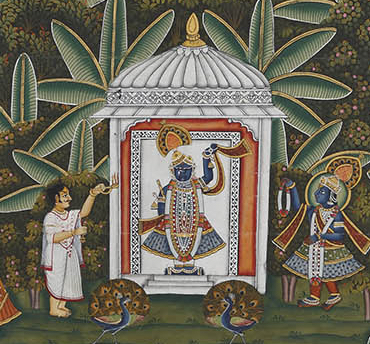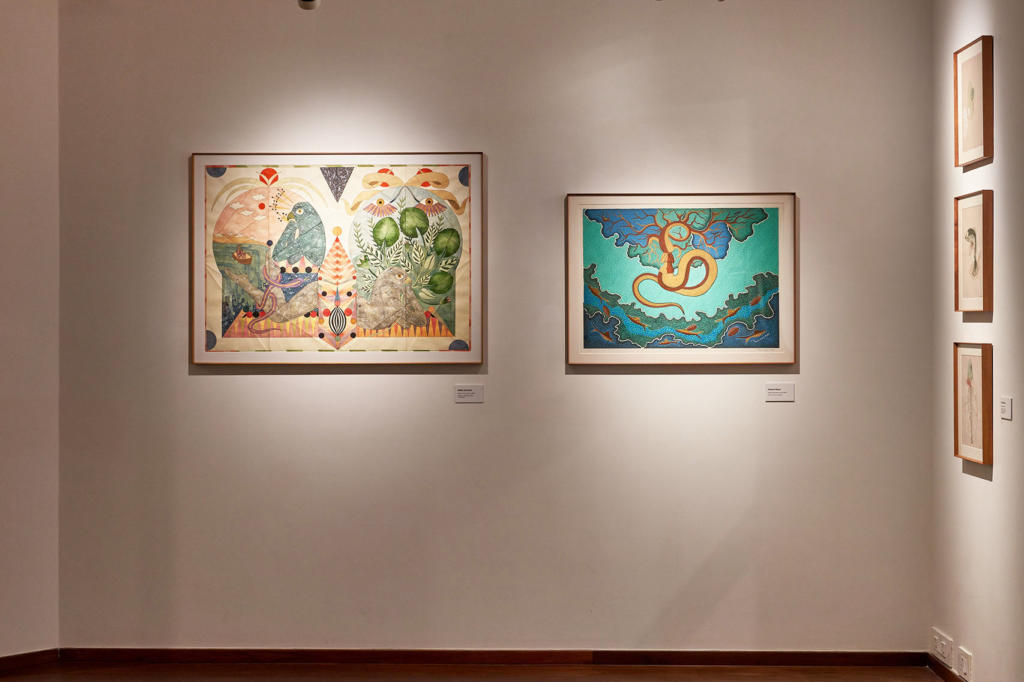
From ‘Shifting Selves – Between meaning, mythology & mirage’ at TARQ
When we enter a Rithika Merchant painting, we become immediately sensitive to certain details that might other escape attention. The voluptuous droop of a flower on the stalk, the earthy comfort of a vivid hue, the ‘female gaze’ that defies attempts at pigeonholing its author and the wonderful lightness with which the artist draws light over dark truths. In our show with TARQ, Shifting Selves – Between meaning, mythology & mirage, we teamed Merchant’s works with other objects from our collection that draw from these same wells of insight and inspiration.
The Human Animal
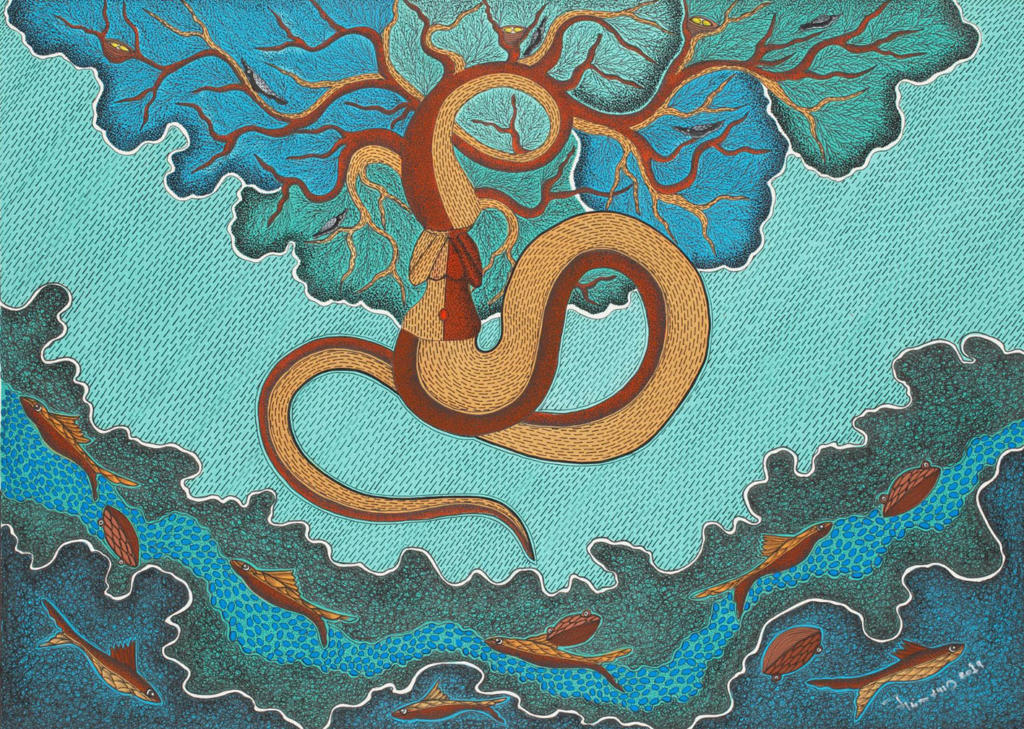
‘Milan’, acrylic and ink on paper, 2019, by Mayank Shyam © Sarmaya Arts Foundation
As she has often pointed out, Merchant is greatly moved by indigenous Indian art traditions, especially Gond. Like many Gond artists, her work too explores the beautifully symbiotic relationship we share with nature. But where she casts a critical eye over the deleterious effect of human progress on nature, the work of second-generation artist Mayank Shyam evokes introspection by taking a spiritual view of this connection.
In his painting titled Milan, Shyam depicts the fertile coming-together of ped and paani, trees and water, the union that nourishes all human life on earth. The canvas uses bright colours, awash in a profusion of blues. The colours and textures blending into one another symbolise the constant process of assimilation that takes place in a forest. These details of the natural world are sacred to the Gond-Pardhan community to which the artist belongs because their deity Bada Dev resides in every furrow and wave, every wing and flank.
Approaching the Divine
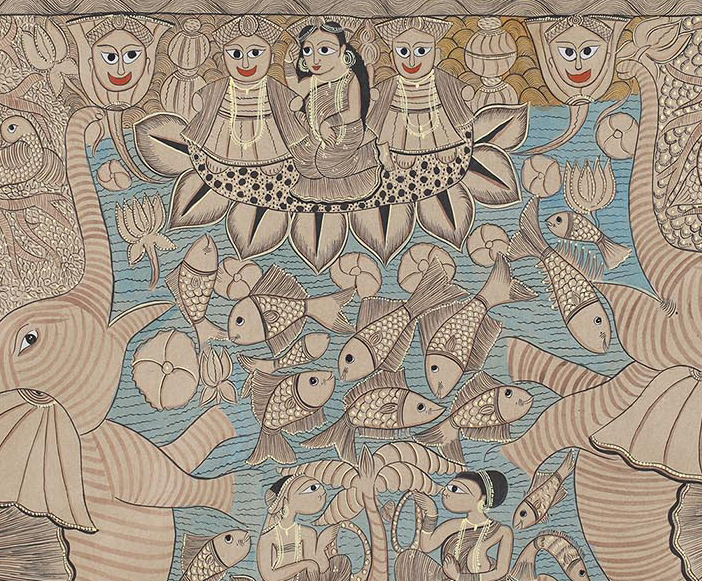
Santhal pattachitra, 2017-2018, by Laltu Chitrakar © Sarmaya Arts Foundation — click to see the full image
Another major Indian tribe, the Santhals use mythology to elevate the natural to the status of the divine, and place themselves in the role of the offspring of the wild world. Their origin story states that the tribe descended from a pair of blind geese, which sprang to life from the saliva of two cows that were fashioned from mud gathered by fishes, turtles and other aquatic life. At the top of this chain of animal ancestors sit Lord Jagannath and his siblings Subhadra and Balaram, granting divine benediction to the tribe and this tale. Laltu Chitrakar narrates this story in the Pattachitra style on a cloth scroll measuring about 7 feet in length. The unfolding of the scroll is part of the drama of the storytelling.
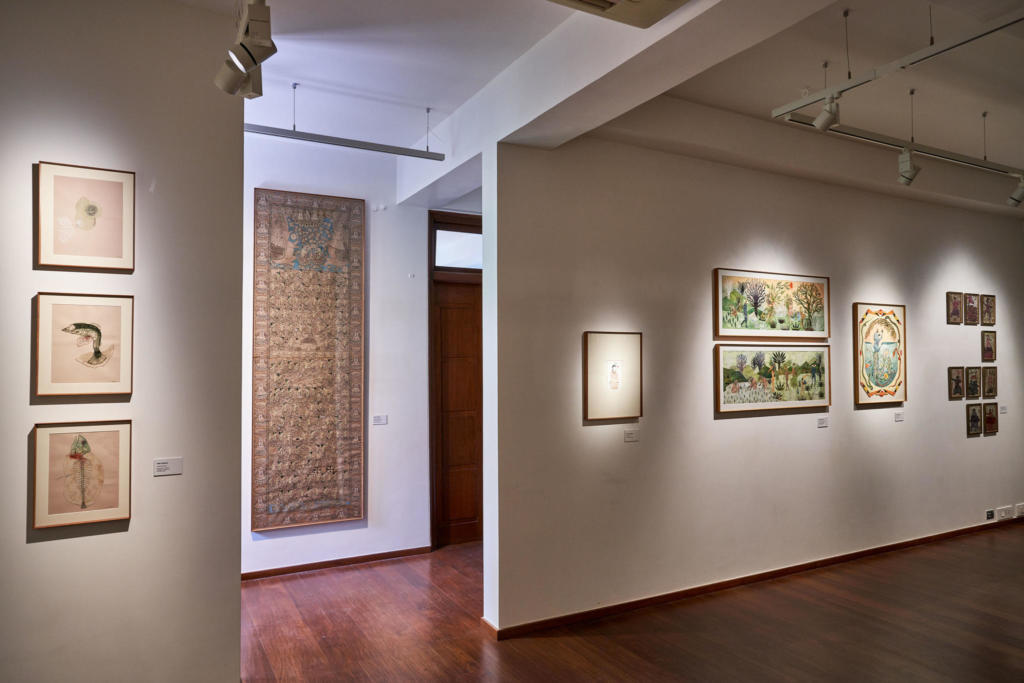
From ‘Shifting Selves – Between meaning, mythology & mirage’ at TARQ
Just as emotional in its appeal as the Santhali origin story is this meditation on life-cycles by Anju Acharya. Titled Unborn, the series documents the natural world with the precision of an engineer and the pain of an empath. Drawing from her own experience of pregnancy, Acharya feels a kinship with all creatures in the cosmos who go through the process of giving birth, one fraught with doubts, anxiety, agony and inexplicable elation. Like Gond and Bengal Pattachitra, her art revels in the interconnections between all living beings.
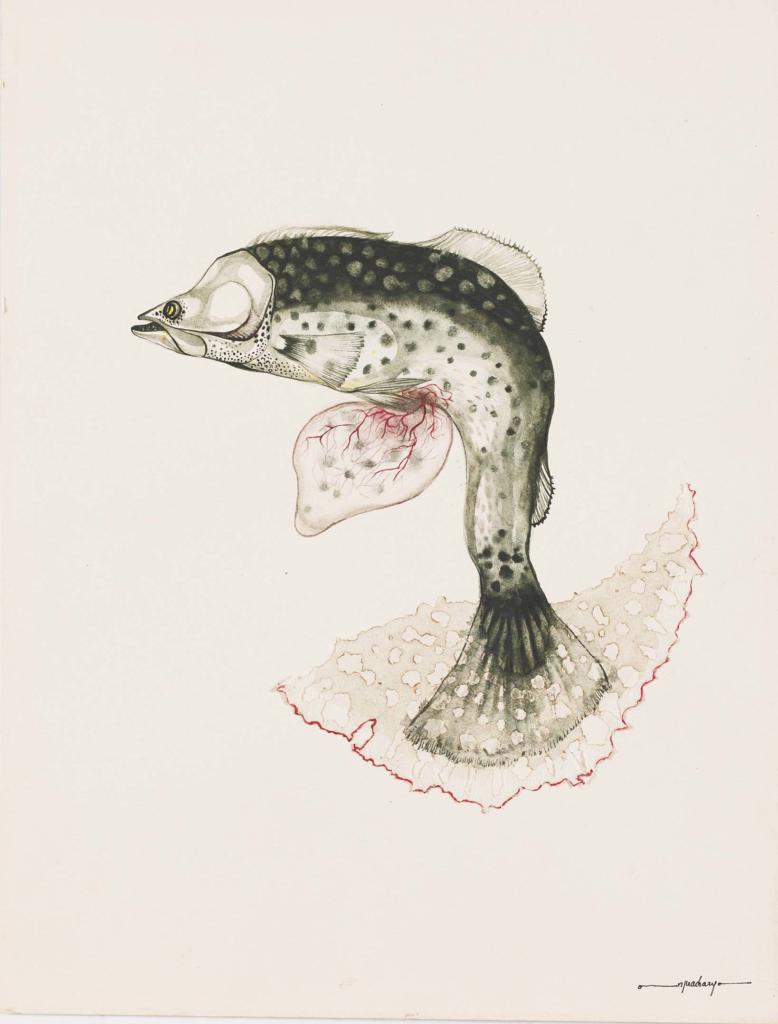
Untitled (Unborn), undated, watercolour, ink and collaged rice paper on cartridge paper, by Anju Acharya © Sarmaya Arts Foundation
Into The Crystal-Ball
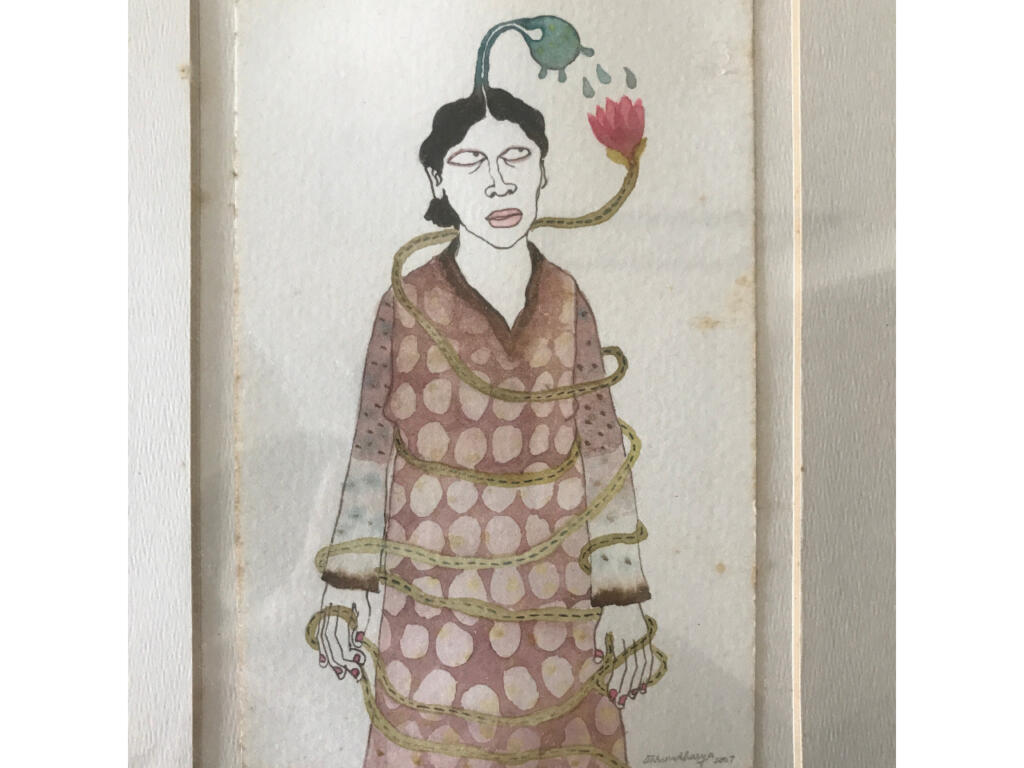
Untitled (Flower stem wrapped around a woman), watercolour on paper, 2007, Dhruvi Acharya © Sarmaya Arts Foundation
Alongside Rithika Merchant’s Tantalus, a tragic myth reinterpreted as a foretelling of a resource-scarce future, we may look at Dhruvi Acharya’s futuristic fantasy. She foresees a dystopian world in which a severe drought has led to mutations that allow some humans to become their own water sources. The untitled 2007 work showing a flower stem wrapped around a woman seems to be the predecessor of the artist’s 2008 show, One Life On Earth, in which figures morph to take on strange functions necessitated by their environment—a world where there is no clean air to breathe, as a result of which the human figures have mutated to be half-plant and half-human.
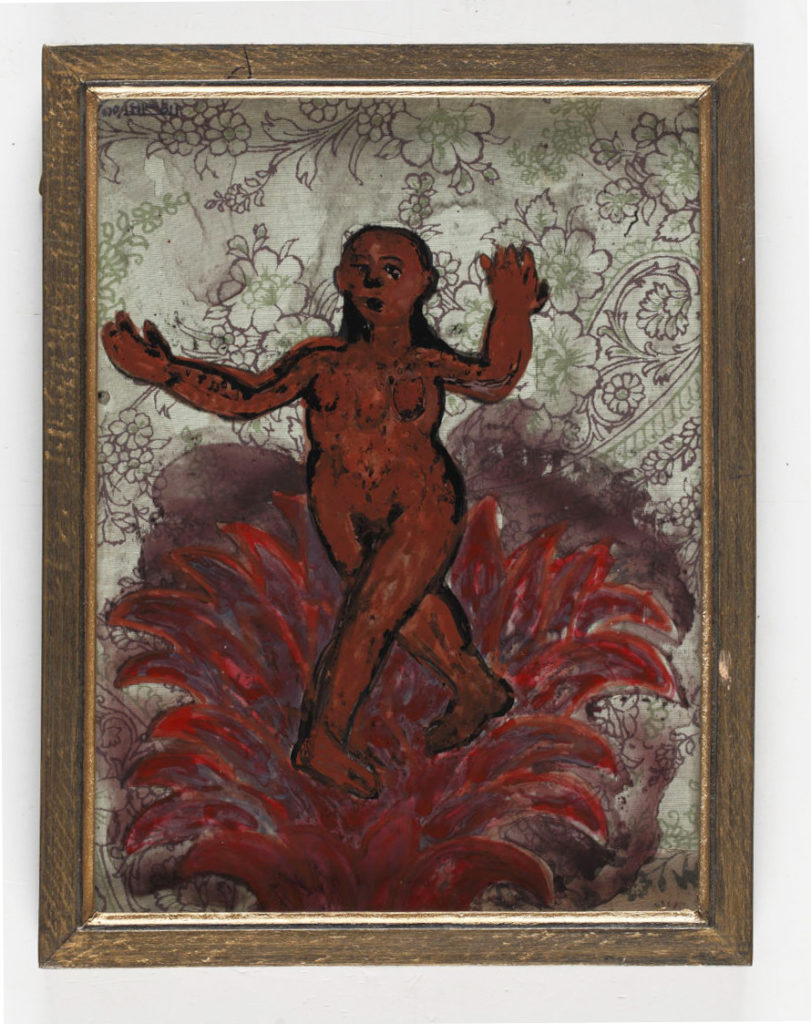
From ‘And When She Roared The Universe Quaked’, 2007, acrylic on glass by Shakuntala Kulkarni © Sarmaya Arts Foundation
With humour, vigour and more than a spoonful of whimsy, Shakuntala Kulkarni’s warriors line up alongside these naturalistic deliberations. Where Rithika Merchant strips her figures of gender to avoid specificity, Kulkarni explores the unattainable ideal imposed on women in her series And when she roared the universe quaked. Her women are amply gendered, and perfectly self-contained. These are female bodies like we rarely see them—devoid of softness and alight with rage, power and humour. Kulkarni’s series offers a cathartic release, the permission to hold uncomfortable truths in our palms for a moment, and then to fully exhale.



